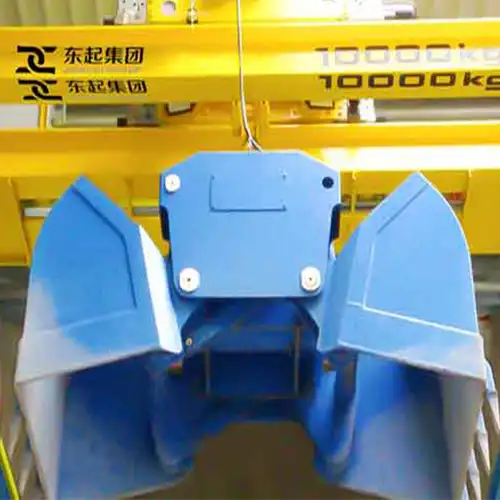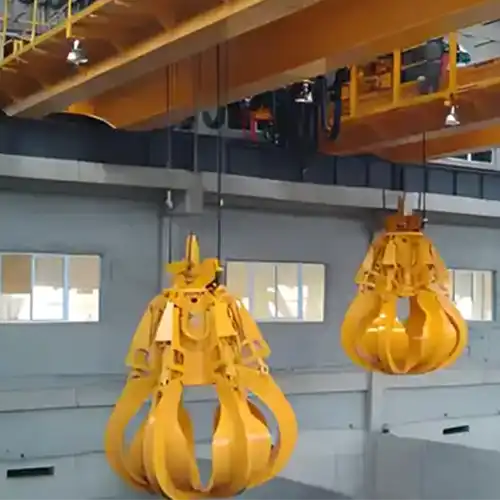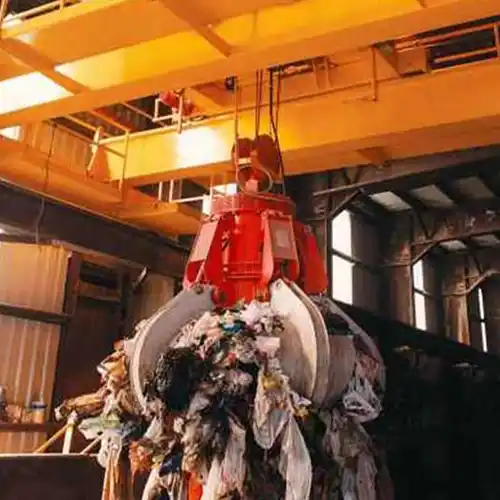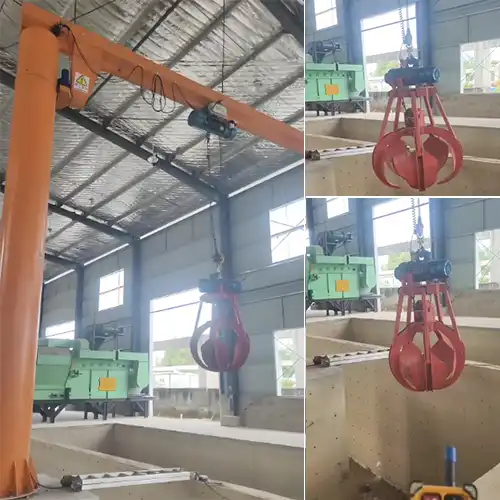What to Know About Custom Crane Grabs: 9 Key Questions
Learn about custom crane grabs with these 9 key questions to ensure you get the perfect design for your needs. Clamshell grab & orange peel grab for sale.
Category: Featured
Your Trusted Overhead Crane Manufacturer & Supplier
What to Know About Custom Crane Grabs: 9 Key Questions
Learn about custom crane grabs with these 9 key questions to ensure you get the perfect design for your needs. Clamshell grab & orange peel grab for sale.
Custom Crane Grabs
Choosing the right custom crane grab is crucial for efficient material handling. To tailor a grab to your specific needs, you need to address nine key questions. These questions will help you gather the necessary information for an accurate quotation and an optimal solution for your operations.

1. What Type of Grab Is Needed?
Types Available
When selecting a crane grab, you typically have two main options:
- Mechanical Grabs: Mechanical grabs, such as 4-rope clamshell buckets, use mechanical linkages and ropes to open and close the grab. They are known for their simplicity and reliability. Mechanical grabs are suitable for handling a variety of materials and are often used in environments where durability and ease of maintenance are critical.
- Hydraulic Grabs: Hydraulic grabs operate using hydraulic cylinders to control the grab's movements. These grabs offer precise control and are ideal for handling materials that require careful management, such as fine aggregates or scrap with varying shapes and sizes. Hydraulic grabs can be more complex but provide greater efficiency and adaptability.
Choosing the Right Type
Selecting between a mechanical or hydraulic grab depends on your specific application needs:
- Material Type: Consider what materials the grab will handle. For example, hydraulic grabs are often preferred for lighter, more delicate materials due to their precise control, while mechanical grabs are effective for heavier, bulkier materials.
- Operational Environment: Evaluate the working conditions. Mechanical grabs are well-suited for harsh environments where simplicity and durability are needed. Hydraulic grabs excel in applications requiring fine control and flexibility.
- Maintenance and Costs: Mechanical grabs generally have lower maintenance requirements and initial costs, while hydraulic grabs, though more expensive, offer enhanced performance and capabilities.
By understanding the differences between these types of grabs and their advantages, you can make an informed decision that best fits your operational requirements.
2. Where Will the Grab Be Installed?
Crane Types
The type of crane where the grab will be installed plays a crucial role in determining the suitable grab design:
- Overhead Crane: Overhead cranes, also known as bridge cranes, are typically used in industrial environments where materials need to be moved across large areas. They provide high lifting heights and long spans. The grab must be compatible with the overhead crane's structure and movement range.
- Gantry Crane: Gantry cranes are similar to overhead cranes but move on tracks or wheels along the ground. They are often used in outdoor settings or for large-scale operations. The grab needs to be designed to fit the gantry crane's lifting capacity and operational environment.
- Crawler Crane: Crawler cranes are mobile cranes that move on tracks, making them ideal for construction sites and uneven terrain. When installing a grab on a crawler crane, ensure the grab's design accommodates the crane's mobility and lifting capability.
Crane Capacity
The crane's lifting capacity is a critical factor in choosing the right grab:
- Matching Grab with Crane Capacity: The grab's weight and design must be compatible with the crane's lifting capacity to ensure safe and efficient operation. If the grab is too heavy or poorly matched, it can strain the crane and reduce performance.
- Safety and Efficiency: Ensuring that the grab's capacity aligns with the crane's lifting ability helps maintain safety and operational efficiency. Overloading the crane can lead to mechanical failures and safety hazards.
- Operational Considerations: Evaluate how often the crane will be used and the types of materials handled. A well-matched grab and crane combination will enhance productivity and reduce wear and tear on both the crane and the grab.
By carefully considering the type of crane and its lifting capacity, you can ensure that the grab you select will operate effectively and safely within your specific setup.
3. How Will the Grab Be Powered?
Power Options
When selecting a grab, it's essential to determine how it will be powered. There are two primary power options:
- Hydraulic: Hydraulic grabs use hydraulic cylinders and fluid pressure to control the opening and closing of the grab. This type of grab offers precise control and can handle a wide range of materials with varying sizes and weights. Hydraulics are particularly useful in applications where fine-tuned movements are needed.
- Mechanical: Mechanical grabs rely on mechanical linkages, such as ropes or chains, to operate. These grabs are typically simpler and more robust, making them suitable for heavy-duty applications. Mechanical grabs are often used in environments where durability and ease of maintenance are priorities.
Considerations
When deciding between hydraulic and mechanical power, consider the following factors:
- Efficiency: Hydraulic grabs generally offer greater efficiency in terms of operation speed and control. They can handle materials more precisely and are often preferred for tasks that require detailed manipulation. Mechanical grabs, while possibly slower, are highly reliable and efficient in environments where less control is needed.
- Maintenance: Hydraulic systems can require more frequent maintenance due to the complexity of hydraulic components and the potential for fluid leaks. Mechanical grabs are usually easier to maintain because of their simpler design, but they may need periodic adjustments to maintain optimal performance.
- Operational Environment: Consider the working environment and the type of materials handled. Hydraulic grabs are advantageous in settings where precision is critical, while mechanical grabs may be better suited for harsh or high-impact environments where robustness is required.
- Cost: Hydraulic grabs tend to have higher initial costs and maintenance expenses compared to mechanical grabs. Evaluate your budget and operational needs to choose the most cost-effective solution.
By understanding the advantages and requirements of each power option, you can select a grab that best meets your operational needs, balancing efficiency, maintenance, and cost considerations.
4. What Materials Will the Grab Handle?
Material Types
The type of materials the grab will handle significantly influences its design and functionality:
- Sand: Sand is a lightweight and granular material. Handling sand requires a grab with a design that can efficiently scoop and transport fine particles without clogging or losing material. Grabs designed for sand often have smooth, wide buckets to prevent buildup and ensure efficient discharge.
- Scrap Iron: Scrap iron, often heavy and irregularly shaped, demands a robust grab that can handle substantial weights and sharp edges. A grab for scrap iron should have reinforced claws or teeth to grip and lift metal fragments securely. Durability is crucial to withstand the abrasive nature of scrap iron.
- Stones: Stones vary in size and weight, requiring a grab that can accommodate different sizes and provide a secure grip. A grab designed for stones typically features strong, sturdy jaws or clamshell buckets capable of handling large, heavy, and potentially sharp materials.
Design Implications
The design of the grab must be tailored to the specific characteristics of the materials it will handle:
- Bucket Design: The shape and size of the bucket or jaws must match the material's dimensions. For granular materials like sand, a wider opening with a smooth finish helps in efficient handling. For bulkier materials like scrap iron or stones, a more robust design with reinforced edges is essential.
- Material Handling Efficiency: The grab must be designed to handle the material effectively, minimizing spillage and ensuring a secure grip. The design should allow for easy loading and unloading, with features that accommodate the material's density and shape.
- Durability and Maintenance: The grab should be built to withstand the wear and tear associated with different materials. For instance, grabs handling abrasive materials like scrap iron may require extra reinforcement, while those handling lighter materials may focus more on efficiency and smooth operation.
- Special Features: Depending on the material, additional features may be needed, such as wear-resistant linings for handling abrasive materials or specialized teeth or claws for gripping irregularly shaped objects.
By understanding the specific materials the grab will handle, you can ensure that the design is optimized for performance, durability, and efficiency in your particular application.
5. What is the Material Density?
Density Specifications
Material density is a crucial factor in designing a grab, as it affects how the grab will handle and lift different materials. Density is typically measured in tons per cubic meter (ton/m³) and provides an indication of how heavy a material is for a given volume.
- Understanding Density: For example, a material with a high density, such as scrap metal, will be heavier per cubic meter compared to a material with lower density, like sand. Accurate knowledge of the material density helps in selecting or designing a grab that can handle the weight effectively.
Impact on Design
The material density directly influences the design and capacity of the grab in several ways:
- Grab Capacity: The grab must be designed to handle the specific weight of the material it will carry. Higher-density materials require grabs with higher lifting capacities and stronger construction to manage the additional weight. For instance, a grab handling dense scrap iron will need to be built to withstand heavier loads compared to one handling lightweight sand.
- Structural Strength: The grab's structural components, including its jaws, bucket, and attachment points, must be reinforced to cope with the stresses induced by high-density materials. This might involve using stronger materials or incorporating additional support features in the grab's design.
- Bucket Size and Shape: The size and shape of the grab's bucket or jaws are influenced by the material's density. For dense materials, a grab with a smaller bucket may be more appropriate to prevent overloading. Conversely, for lighter materials, a larger bucket may be suitable to increase handling efficiency.
- Operational Efficiency: Grabs must be designed to handle the material efficiently, minimizing the time required to fill and discharge the load. For higher-density materials, the design may need to include features that facilitate quicker handling and reduce strain on the crane.
- Wear and Tear: Higher-density materials can cause more wear and tear on the grab. Ensuring that the grab is equipped with wear-resistant linings or robust construction can help extend its lifespan and reduce maintenance needs.
By understanding the material density, you can ensure that the grab is designed to handle the specific demands of your operation, optimizing both performance and durability.
6. What is the Required Grab Capacity?
Capacity Requirements
Grab capacity is a fundamental aspect to consider when selecting or designing a custom crane grab. This capacity, measured in tons, indicates the maximum weight the grab can handle effectively in a single operation.
- Understanding Capacity: Knowing the required grab capacity helps ensure that the equipment can safely and efficiently handle the volume of material you need to move. For instance, if your operation involves lifting large quantities of heavy scrap metal, you'll need a grab with a higher capacity compared to one used for lighter, bulkier materials like sand.
Determining the Right Size
Selecting the appropriate grab size involves matching its capacity with the type of material and its density:
- Material Type and Density: The type of material you're handling and its density are crucial in determining the right grab capacity. Dense, heavy materials like scrap iron require grabs with higher capacity ratings to safely manage the load. Conversely, materials with lower density, such as sand, might not require as high a capacity.
- Load Factors: Consider how much material the grab will be expected to lift per cycle. This includes evaluating the typical load size and the frequency of lifting operations. A grab with an adequate capacity will minimize the need for multiple cycles and improve overall efficiency.
- Safety and Efficiency: Ensuring the grab has the appropriate capacity is vital for safety and operational efficiency. Overloading a grab can lead to mechanical failures or unsafe working conditions. The grab should be sized to handle the maximum expected load without strain.
- Operational Considerations: Take into account the specific conditions under which the grab will be used, including the height of lift, the distance material needs to be transported, and the crane's lifting capability. These factors can influence the grab size and its capacity requirements.
By carefully assessing the required grab capacity in relation to the material type and density, you can select a grab that ensures efficient, safe, and reliable material handling for your operations.
7. What is the Power Supply Specification?
Typical Specifications
Power supply specifications are crucial for ensuring that the grab operates efficiently and safely within your existing setup. The most common power supply specifications for crane grabs include:
- 380V, 50Hz, 3-Phase: This is a standard power supply configuration used in many industrial environments. It provides a stable and consistent power source suitable for most hydraulic and mechanical grabs. This specification supports robust performance and reliable operation.
Alternatives
Depending on your facility's power infrastructure or specific operational requirements, other power supply configurations might be needed:
- Different Voltages: Some installations may require power supplies at different voltages, such as 220V or 400V, based on regional standards or equipment compatibility.
- Frequency Variations: In regions where the power frequency is different (e.g., 60Hz instead of 50Hz), the grab's power system must be adjusted accordingly to ensure proper function.
- Phase Requirements: While 3-phase power is standard, some applications may use single-phase power. Ensure that the grab's design accommodates these requirements if needed.
Importance
Proper power supply specification is essential for the following reasons:
- Compatibility with Existing Systems: The grab must be compatible with your current power infrastructure to operate correctly. Mismatched power requirements can lead to inefficiencies, equipment damage, or operational downtime.
- Operational Efficiency: Ensuring that the grab is powered appropriately helps maintain its performance and efficiency. Incorrect power supply can affect the grab's operational capabilities and overall productivity.
- Safety: Correct power supply alignment is critical for the safety of both the equipment and personnel. Using the wrong power specification can pose electrical hazards and lead to equipment failure.
- Cost Considerations: Aligning the power supply with existing systems can reduce additional costs associated with modifying or upgrading your power infrastructure.
By verifying the power supply specifications and ensuring compatibility with your existing systems, you can ensure smooth operation, maintain safety standards, and optimize performance for your custom crane grab.
8. How Frequently Will the Crane Operate Daily?
Usage Frequency
Understanding how often the crane will be used each day is crucial for selecting the appropriate grab. This involves assessing:
- Daily Operational Hours: Determine the number of hours the crane will be in operation each day. This could range from a few hours to continuous operation depending on your facility's needs. High usage rates require grabs designed to withstand frequent use without compromising performance.
Effects on Grab Selection
The frequency of crane operation impacts several aspects of grab selection:
- Durability: For cranes operating frequently or continuously, the grab must be built with high durability to handle the repetitive stresses. This means choosing materials and construction methods that can withstand constant use without significant wear and tear.
- Maintenance Needs: Frequent operation can increase maintenance requirements. A grab used extensively may need more regular inspections and part replacements to ensure ongoing reliability and performance. Select a grab that is easy to maintain and has readily available replacement parts.
- Operational Efficiency: High-frequency use necessitates a grab designed for optimal efficiency to minimize downtime. Features that support quick loading and unloading, as well as robust performance under continuous use, are essential.
- Wear and Tear: Consider how the grab's design will handle the specific demands of frequent use. Components such as hydraulic cylinders or mechanical linkages should be designed to endure the rigors of daily operation, reducing the likelihood of breakdowns.
- Cost Implications: While more durable grabs may have a higher initial cost, they can offer better long-term value by reducing maintenance needs and operational disruptions. Evaluating the cost-benefit ratio of different grab options based on usage frequency can help in making an informed decision.
By accurately assessing the crane's daily operational frequency, you can select a grab that is both durable and efficient, ensuring reliable performance and minimizing maintenance requirements.
9. Do You Need a CFR Quotation?
CFR Terms
CFR (Cost and Freight) is an international trade term that defines the seller's responsibilities in the shipping process:
Cost and Freight Details: Under CFR terms, the seller covers the cost of the goods and freight charges to transport the items to the designated port of destination. However, the buyer is responsible for additional costs such as insurance and import duties. It's important to understand these terms to ensure clarity on what expenses will be covered and what will be required from your end.
Destination Port Information
Providing accurate destination port information is essential for a precise CFR quotation:
- Necessary for Accurate Quoting: To generate a detailed and accurate CFR quotation, you need to specify the exact port where the crane grab will be delivered. This information affects shipping costs, transit times, and logistical arrangements. Without the correct port details, there may be discrepancies in the quotation, leading to potential delays or additional charges.
- Impact on Cost and Delivery: The destination port can significantly impact the overall cost and delivery time of the crane grab. Ports with higher traffic or longer distances may incur higher freight costs. Accurate port information ensures that the quotation reflects these factors accurately, helping you budget effectively and plan for timely delivery.
By understanding CFR terms and providing precise destination port information, you can ensure that the quotation for your crane grab is accurate and reflects all relevant costs, facilitating a smoother purchasing process. Click to get how to get a detailed quotation on custom bucket grab for your needs.
Conclusion: Tailoring Your Custom Crane Grab
Selecting the right custom crane grab requires careful consideration of several key factors to ensure optimal performance, safety, and efficiency. By addressing the nine essential questions outlined, you can make an informed decision that aligns with your operational needs.
- Grab Type: Determine whether a mechanical or hydraulic grab best suits your application. Mechanical grabs offer durability and simplicity, while hydraulic grabs provide precise control and adaptability.
- Crane Compatibility: Ensure that the grab is compatible with the type of crane it will be installed on, whether it's an overhead crane, gantry crane, or crawler crane. Matching the grab with the crane's lifting capacity is crucial for safe and effective operation.
- Power Supply: Specify the power supply requirements to match your existing infrastructure, whether it's a standard 380V, 50Hz, 3-phase or an alternative configuration. Proper power supply ensures reliable operation and compatibility with your systems.
- Material Handling: Consider the types of materials the grab will handle, such as sand, scrap iron, or stones. The design should be tailored to efficiently manage the material's characteristics and density.
- Material Density: Know the density of the materials to be handled, as this affects the grab's capacity and structural design. High-density materials require stronger and more durable grabs.
- Grab Capacity: Choose a grab with the appropriate capacity to handle the maximum weight of materials. This ensures safety and operational efficiency, preventing overloading and mechanical issues.
- Operational Frequency: Assess how frequently the crane will be in use each day. A grab designed for high-frequency operation should be robust and require minimal maintenance.
- CFR Quotation: If a CFR (Cost and Freight) quotation is needed, provide accurate destination port information. This helps in calculating shipping costs and ensuring a precise quotation.
By carefully evaluating these factors and providing detailed information, you can tailor a custom crane grab that meets your specific requirements, enhancing productivity and ensuring a smooth operational process.
Related Products

Latest project
150 Ton Overhead Crane Installation Feedback – Paraguay Case
QDX 150 ton overhead crane in action in Paraguay. Installation photos, video, and client feedback show performance, safety, and heavy-lifting efficiency.
Free consultation to Confirm Parameters & Specifications and Get
Latest Crane Price & Crane Rate.
- Types of overhead cranes : _______?
- Optional: Overhead travelling crane, goliath gantry crane,Slewing jib crane, Single girder or double girder crane,small portable crane or kbk crane, etc.
- Capacity of overhead crane: _______?
- Optional: 0.25ton, 0.5 ton, 1 ton, 2 ton, 3ton, 5 ton, 10 ton,15ton, 20ton, 25 ton, 30ton,35ton, up to 550ton, etc.
- Crane span & lifting height : _______?
- Crane travelling length : _____?
- Control of overhead crane:_______?
- Optional: pendant/ remote/cabin control
- Voltage supply of overhead crane:_____?
- Eg,: 380V50/60HZ,3Phase or others,etc.
- Application/usage of crane:_______?
- Eg,: Steel mill, ,injection mold, cement,stone, concrete,granite, general manufacturing, etc.
Just leave a message via the contact form and our hoist and crane engineer will contact you with in 24working hours.
Get In Touch



